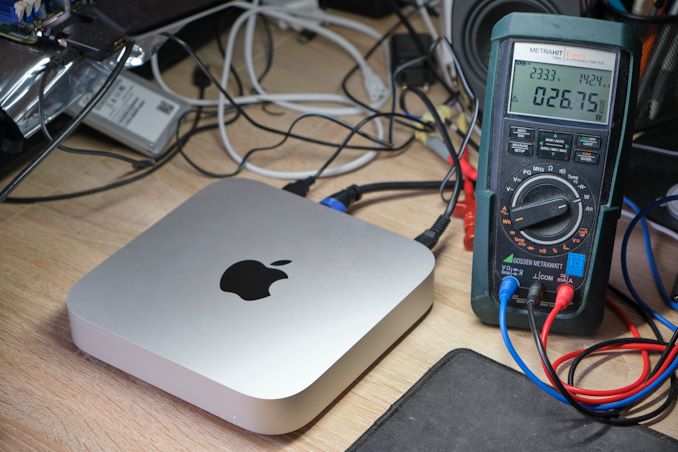The 2020 Mac Mini Unleashed: Putting Apple Silicon M1 To The Test
by Andrei Frumusanu on November 17, 2020 9:00 AM ESTConclusion & First Impressions
Today’s piece was less of a review on the new Mac mini as it was testing out Apple’s new M1 chip. We’ve had very little time with the device but hopefully were able to manage to showcase the key aspects of the new chip, and boy, it’s impressive.
For years now we’ve seen Apple’s custom CPU microarchitecture in A-series phone SoCs post impressive and repeated performance jumps generation after generation, and it today’s new Apple Silicon devices are essentially the culmination of the inevitable trajectory that Apple has been on.
In terms of power, the Apple M1 inside of the new Mac mini fills up a thermal budget up to around 20-24W from the SoC side. This is still clearly a low-power design, and Apple takes advantage of that to implement it into machines such as the now fan-less Macbook Air. We haven’t had opportunity to test that device yet, but we expect the same peak performance, although with more heavy throttling once the SoC saturates the heat dissipation of that design.
In the new Macbook Pro, we expect the M1 to showcase similar, if not identical performance to what we’ve seen on the new Mac mini. Frankly, I suspect Apple could have down-sized the Mini, although we don’t exactly now the internal layout of the piece as we weren’t allowed to disassemble it.
The performance of the new M1 in this “maximum performance” design with a small fan is outstandingly good. The M1 undisputedly outperforms the core performance of everything Intel has to offer, and battles it with AMD’s new Zen3, winning some, losing some. And in the mobile space in particular, there doesn’t seem to be an equivalent in either ST or MT performance – at least within the same power budgets.
What’s really important for the general public and Apple’s success is the fact that the performance of the M1 doesn’t feel any different than if you were using a very high-end Intel or AMD CPU. Apple achieving this in-house with their own design is a paradigm shift, and in the future will allow them to achieve a certain level of software-hardware vertical integration that just hasn’t been seen before and isn’t achieved yet by anybody else.
The software side of things already look good on day 1 due to Apple’s Rosetta2. Whilst the software doesn’t offer the best the hardware can offer, with time, as developers migrate their applications to native Apple Silicon support, the ecosystem will flourish. And in the meantime, the M1 is fast enough that it can absorb the performance hit from Rosetta2 and still deliver solid performance for all but the most CPU-critical x86 applications.
For developers, the Apple Silicon Macs also represent the very first full-fledged Arm machines on the market that have few-to-no compromises. This is a massive boost not just for Apple, but for the larger Arm ecosystem and the growing Arm cloud-computing business.
Overall, Apple hit it out of the park with the M1.











682 Comments
View All Comments
Der Keyser - Tuesday, November 17, 2020 - link
This release is going to be an interesting change in the industryKevin G - Tuesday, November 17, 2020 - link
There is also the business side of it too which is gonna be full of Game of Thones-like drama with nVidia attempting to acquire ARM. Apple and nVidia notoriously don't get along. Apple's relationship with Imagination Technologies is also strained but they've seemingly made up so that Apple can gain access to some ray tracing acceleration designs. Apple still seems to be on good terms with AMD but moving away from them as a supplier on the Mac side right now due to the ARM transition in general.YesYesNo - Tuesday, November 17, 2020 - link
Thankfully chaos is a ladder.helios24 - Tuesday, November 17, 2020 - link
Apple has an Architecture License with ARM. Basically the broadest license that ARM sells. If you didn't know this, ARM was founded as a joint venture between Apple and Acorn. Apple's license is also perpetual. That is the reason why Apple isn't interested in acquiring ARM. Apple does not use ARM designs, they use certain principles present in the ARM architecture and the ISA. Apple then makes cpus that can run ARM instruction set, that is the reason why you see big difference between apple designed SoC vs Qualcomm or ARM design.Tams80 - Tuesday, November 17, 2020 - link
Apple's not interested in buying ARM mainly because it would never be allowed to happen (without Apple splitting up), so trying to do so would be a complete waste of time.dejuknow - Tuesday, November 17, 2020 - link
Nope. Apple would still have no reason to purchase ARM even if it were allowed to happen. helios24 is completely correct. Apple has no interest in licensing technology to third parties.nevernotmaybe - Friday, November 20, 2020 - link
Apple cares about nothing other than making money, if they could have a subsidiary printing money while they continue as normal they would do it instantly. The idea they wouldn't is laughable.skingers - Monday, November 23, 2020 - link
Not laughable at all. Apple have tonnes of free cash that they could use to buy something they don't really need that makes money, but they don't do it. Instead they buy back their own stock. The other commenters here are correct, Apple already have, in perpetuity, what they need for their chip designs and they are backing themselves to be best in the business at it.helpmeoutnow - Thursday, November 26, 2020 - link
but they were never the best in the business, so how come?alysdexia - Monday, December 28, 2020 - link
die, troll http://google.com/search?q=Apple+TCO